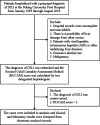Differences in clinical characteristics among 726 patients with Chinese herbal medicine- or Western medicine-induced liver injury
- PMID: 35960048
- PMCID: PMC9371566
- DOI: 10.1097/MD.0000000000029909
Differences in clinical characteristics among 726 patients with Chinese herbal medicine- or Western medicine-induced liver injury
Abstract
The differences between Chinese herbal medicine (CHM)- and Western medicine (WM)-induced liver injury have rarely been reported. Our aim was to investigate the clinical features of patients with drug-induced liver injury (DILI) caused by CHM or WM. The medical records of 726 DILI patients were retrospectively collected at Peking University First Hospital from January 1995 through August 2019. The number of inpatients with DILI in our hospital showed an increasing trend over time. The incidence of DILI caused by CHM exhibited a linear trend toward an increase with time (P = .0012). Of the 726 DILI patients, females accounted for 65.8%. There were 353 cases (48.6%) caused by CHM and 225 cases (40.0%) caused by WM. The 3 most common causative CHMs were Polygonum multiflorum (38 cases), Fructus Psoraleae (35 cases), and Epimedium (26 cases). The proportions of female patients, alanine aminotransferase (ALT) levels, aspartate aminotransferase (AST) levels, total bilirubin (TBIL) levels and antinuclear antibody (ANA) positivity rates among cases caused by CHM were higher than those of cases caused by WM (P < .05). There were more patients with severe cases caused by CHM than with severe cases caused by WM (P < .05). The clinical characteristics of DILI caused by CHM differ from those caused by WM. The incidence of DILI caused by CHM is increasing yearly. The medication time of DILI caused by CHM is longer than that of DILI caused by WM, and the severity is greater. Therefore, it is necessary to scientifically and rationally use traditional CHM and monitor liver function. For DILI caused by CHM, the CHM prescription should be recorded in detail to provide detailed clinical data for scientific research on the liver toxicity of CHM.
Copyright © 2022 the Author(s). Published by Wolters Kluwer Health, Inc.
Conflict of interest statement
The authors declare that they have no competing interests.
Figures
Similar articles
-
Hepatobiliary and pancreatic: Comparison between Chinese herbal medicine and Western medicine-induced liver injury of 1985 patients.J Gastroenterol Hepatol. 2016 Aug;31(8):1476-82. doi: 10.1111/jgh.13323. J Gastroenterol Hepatol. 2016. PMID: 26896664
-
[Comparison of clinical characteristics between patients with Polygonum multiflorum-induced liver injury and those with other drug-induced liver injuries].Zhonghua Gan Zang Bing Za Zhi. 2025 May 20;33(5):463-469. doi: 10.3760/cma.j.cn501113-20250216-00058. Zhonghua Gan Zang Bing Za Zhi. 2025. PMID: 40528591 Chinese.
-
Causes, Features, and Outcomes of Drug-Induced Liver Injury in 69 Children from China.Gut Liver. 2015 Jul;9(4):525-33. doi: 10.5009/gnl14184. Gut Liver. 2015. PMID: 25717050 Free PMC article.
-
Research Advances on Hepatotoxicity of Herbal Medicines in China.Biomed Res Int. 2016;2016:7150391. doi: 10.1155/2016/7150391. Epub 2016 Dec 18. Biomed Res Int. 2016. PMID: 28078299 Free PMC article. Review.
-
The hepatotoxicity of Polygonum multiflorum: The emerging role of the immune-mediated liver injury.Acta Pharmacol Sin. 2021 Jan;42(1):27-35. doi: 10.1038/s41401-020-0360-3. Epub 2020 Mar 2. Acta Pharmacol Sin. 2021. PMID: 32123300 Free PMC article. Review.
References
-
- Chalasani NP, Maddur H, Russo MW, et al. . Reddy KR: ACG clinical guideline: diagnosis and management of idiosyncratic drug-induced liver injury. Am J Gastroenterol. 2021;116:878–98. - PubMed
-
- Bernal W, Auzinger G, Dhawan A, et al. . Acute liver failure. Lancet. 2010;376:190–201. - PubMed
-
- Suk KT, Kim DJ, Kim CH, et al. . A prospective nationwide study of drug-induced liver injury in Korea. Am J Gastroenterol. 2012;107:1380–7. - PubMed
-
- Shen T, Liu Y, Shang J, et al. . Incidence and etiology of drug-induced liver injury in mainland China. Gastroenterology. 2019;156:2230–2241.e11. - PubMed
MeSH terms
Substances
LinkOut - more resources
Full Text Sources
Medical





